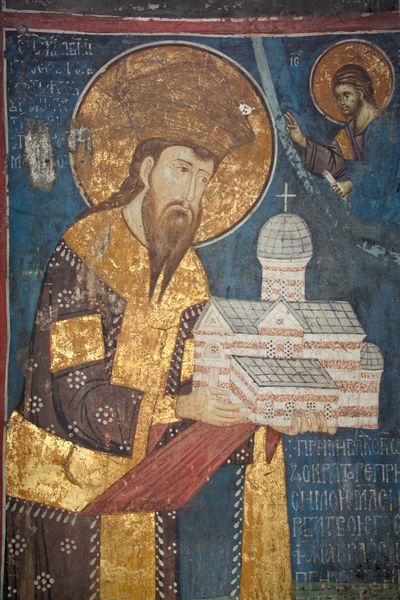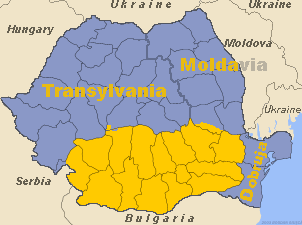|
Baciu Church
The Baciu Church is a Romanian Orthodox church located at 56 Alexandru Ioan Cuza Street, Săcele, Romania. Located in Baciu, a former village that is now a district of Săcele, it is dedicated to Saint Nicholas. The church was built between 1776 and 1808 on the highest hill in the city. An old wooden church was adjacent to the site; there is now a funerary chapel in its place; the site of the former altar is marked by a stone cross from 1808. The lead ''ktetor'' was Urs Gâlă, who sold over 800 young sheep and donated the money to help build the church. He and other donors are commemorated on a stone plaque above the nave door.Description at the Săcele tourist office site The cruciform church sits in a nearly circular yard that serves as a parish cemetery. It is 29.74 meters long, 16.11 meters wide ... [...More Info...] [...Related Items...] OR: [Wikipedia] [Google] [Baidu] |
Romanian Orthodox
The Romanian Orthodox Church (ROC; , ), or Romanian Patriarchate, is an autocephalous Eastern Orthodox church in full communion with other Eastern Orthodox Christian churches, and one of the nine patriarchates in the Eastern Orthodox Church. Since 1925, the church's Primate has borne the title of Patriarch. Its jurisdiction covers the territories of Romania and Moldova, with additional dioceses for Romanians living in nearby Ukraine, Serbia and Hungary, as well as for diaspora communities in Central and Western Europe, North America and Oceania. It is the only autocephalous church within Eastern Orthodoxy to have a Romance language for liturgical use. The majority of Romania's population (16,367,267, or 85.9% of those for whom data were available, according to the 2011 census data), as well as some 720,000 Moldovans, belong to the Romanian Orthodox Church. Members of the Romanian Orthodox Church sometimes refer to Orthodox Christian doctrine as ''Dreapta credință'' ("right ... [...More Info...] [...Related Items...] OR: [Wikipedia] [Google] [Baidu] |
Săcele
Săcele (; German: ''Siebendörfer''; Hungarian: ''Négyfalu'', between 1950 and 2001 ''Szecseleváros'') is a city in Brașov County, Romania, in the Burzenland area of southeastern Transylvania, with a population of 30,920 inhabitants in 2021. It is adjacent to the city of Brașov, its city centre being situated away from downtown Brașov. History The city since 1950 is composed of former villages which now form the main sectors: Baciu (Bácsfalu, Batschendorf), Turcheș (Türkös, Türkeschdorf), Cernatu (Csernátfalu, Zerndorf), and Satulung (Hosszúfalu, Langendorf). After the second half of the 11th century the villages were mentioned as "''septem villae valacheles''" (seven Vlach villages). The first official mention of Săcele was a document issued on May 16, 1366, by the Hungarian King Louis I of Hungary in which he offers the area between the Timiș and Olt rivers to a trusted friend—Count Stanislav. Later it was under the Saxon management of Kronstadt (Brașov ... [...More Info...] [...Related Items...] OR: [Wikipedia] [Google] [Baidu] |
Saint Nicholas
Saint Nicholas of Myra (traditionally 15 March 270 – 6 December 343), also known as Nicholas of Bari, was an early Christian bishop of Greeks, Greek descent from the maritime city of Patara (Lycia), Patara in Anatolia (in modern-day Antalya Province, Turkey) during the time of the Roman Empire. Because of the many miracles attributed to his intercession, he is also known as Nicholas the Wonderworker. Saint Nicholas is the patron saint of sailors, merchants, archers, repentant thieves, children, brewers, pawnbrokers, toymakers, unmarried people, and students in various cities and countries around Europe. His reputation evolved among the pious, as was common for early Christian saints, and his legendary habit of secret gift-giving gave rise to the folklore of Santa Claus ("Saint Nick") through Sinterklaas. Little is known about the historical Saint Nicholas. The earliest accounts of his life were written centuries after his death and probably contain legendary elaborations. H ... [...More Info...] [...Related Items...] OR: [Wikipedia] [Google] [Baidu] |
Ktetor
''Ktetor'' () or ''ktitor'' (; ka, ქტიტორი ; ), meaning 'founder', is a title given in the Middle Ages to the provider of funds for construction or reconstruction of an Eastern Orthodox church or monastery, for the addition of icons, frescos, and other works of art. It was used in the Byzantine sphere. A Catholic equivalent of the term is ''donator''. At the time of founding, the ktetor often issued typika, and was illustrated on fresco Fresco ( or frescoes) is a technique of mural painting executed upon freshly laid ("wet") lime plaster. Water is used as the vehicle for the dry-powder pigment to merge with the plaster, and with the setting of the plaster, the painting become ...es ("ktetor portrait"). The female form is () or ''ktitoritsa'' (). Sources * * History of Eastern Orthodoxy Philanthropy Culture of the Byzantine Empire Greek words and phrases {{Orthodoxy-stub ... [...More Info...] [...Related Items...] OR: [Wikipedia] [Google] [Baidu] |
Brașov
Brașov (, , ; , also ''Brasau''; ; ; Transylvanian Saxon dialect, Transylvanian Saxon: ''Kruhnen'') is a city in Transylvania, Romania and the county seat (i.e. administrative centre) of Brașov County. According to the 2021 Romanian census, 2021 census, with 237,589 inhabitants, Brașov is the Cities in Romania, 6th most populous city in Romania. The Brașov metropolitan area, metropolitan area was home to 371,802 residents. Brașov is located in the central part of the country, about north of Bucharest and from the Black Sea. It is surrounded by the Southern Carpathians and is part of the historical region of Transylvania. Historically, the city was the centre of the Burzenland (), once dominated by the Transylvanian Saxons (), and a significant commercial hub on the trade roads between Austria (then Archduchy of Austria, within the Habsburg monarchy, and subsequently Austrian Empire) and Turkey (then Ottoman Empire). It is also where the Deșteaptă-te, române!, nationa ... [...More Info...] [...Related Items...] OR: [Wikipedia] [Google] [Baidu] |
Sfântu Gheorghe
Sfântu Gheorghe (; or ''Szentgyörgy'' ; ; English lit.: ''Saint George'') is a city that serves as the seat of Covasna County in Transylvania, Romania. Located in the central part of the country, it lies on the Olt River in a valley between the Baraolt Mountains and the . The town administers two villages, Chilieni (''Kilyén'') and Coșeni (''Szotyor''). History Sfântu Gheorghe is one of the oldest urban settlements in Transylvania, the town first having been documented in 1332. The town takes its name from Saint George, the patron of the local church. Historically, it was also known in German as ''Sankt Georgen''. The "sepsi" prefix (''sebesi'' → ''sepsi'', meaning "of Sebes") refers to the area which the ancestors of the local Székely population had inhabited before settling to the area of the town. The previous area of their settlement was around the town of "Sebes" (now Sebeș, in Alba County) which later became populated mainly by Transylvanian Saxons (), being ... [...More Info...] [...Related Items...] OR: [Wikipedia] [Google] [Baidu] |
Narthex
The narthex is an architectural element typical of Early Christian art and architecture, early Christian and Byzantine architecture, Byzantine basilicas and Church architecture, churches consisting of the entrance or Vestibule (architecture), vestibule, located at the west end of the nave, opposite the church's main altar. Traditionally the narthex was a part of the church building, but was not considered part of the church proper. In early Christian churches the narthex was often divided into two distinct parts: an esonarthex (inner narthex) between the west wall and the body of the church proper, separated from the nave and aisles by a wall, arcade (architecture), arcade, colonnade, screen, or rail, and an external closed space, the exonarthex (outer narthex), a court in front of the church façade delimited on all sides by a colonnade as in the first Old St. Peter's Basilica, St. Peter's Basilica in Rome or in the Basilica of Sant'Ambrogio in Milan. The exonarthex may have bee ... [...More Info...] [...Related Items...] OR: [Wikipedia] [Google] [Baidu] |
Michael The Brave
Michael the Brave ( or ; 1558 – 9 August 1601), born as Mihai Pătrașcu, was the Prince of Wallachia (as Michael II, 1593–1601), Prince of Moldavia (1600) and ''de facto'' ruler of Principality of Transylvania (1570–1711), Transylvania (1599–1600). He is considered one of Romania's greatest national heroes. Since the 19th century, Michael the Brave has been regarded by Romanian nationalism, Romanian nationalists as a symbol of Romanian unity, as his reign marked the first time in history all principalities inhabited by Romanians were under the same ruler. His rule over Wallachia began in the autumn of 1593. Two years later, Long Turkish War, war with the Ottoman Empire, Ottomans began, a conflict in which the Prince fought the Battle of Călugăreni, resulting in a victory against an army nearly three times the size of the army of Michael the Brave, considered one of the most important battles of his reign. Although the Wallachians emerged victorious from the battle, ... [...More Info...] [...Related Items...] OR: [Wikipedia] [Google] [Baidu] |
Monument Istoric
The National Register of Historic Monuments () is the official English name of the Romania government's list of national heritage sites known as Monumente istorice. In Romania, these include sites, buildings, structures, and objects considered worthy of preservation due to the importance of their Romanian cultural heritage. The list, created in 2004, contains places that have been designated by the Ministry of Culture and National Patrimony of Romania and are maintained by the Romanian National Institute of Historical Monuments, as being of national historic significance. Criteria A ''Monument istoric'' ("Historic monument") is defined as: * An architectural or sculptural work, or archaeological site. * Having significant cultural heritage value, and of immovable scale. * Perpetuating the memory of an event, place, or historical personality. ''Monumente istorice'' cultural properties include listed Romanian historical monuments from the National Register of Historic Monume ... [...More Info...] [...Related Items...] OR: [Wikipedia] [Google] [Baidu] |
Ministry Of Culture And Religious Affairs (Romania)
The Ministry of Culture of Romania () is one of the ministries of the Government of Romania. The current position holder is Natalia-Elena Intotero from the Social Democratic Party (Romania), Social Democratic Party (PSD). The Romanian National Institute of Historical Monuments, part of this ministry, maintains the List of monumente istorice in Romania, list of historical monuments in Romania. The list, created in 2004–2005, contains Monument istoric, historical monuments entered in the National Cultural Heritage of Romania. List of Culture Ministers See also * Culture of Romania * List of monumente istorice in Romania, List of historical monuments in Romania References External links MCC.ro* GUV.roRomanian National Institute of Historical MonumentsList of Historical Monumentsat Romanian Ministry of Culture and National Patrimony (in Romanian) at Romanian National Institute of Historical Monuments (in Romanian) Government ministries of Romania, Culture Cult ... [...More Info...] [...Related Items...] OR: [Wikipedia] [Google] [Baidu] |







